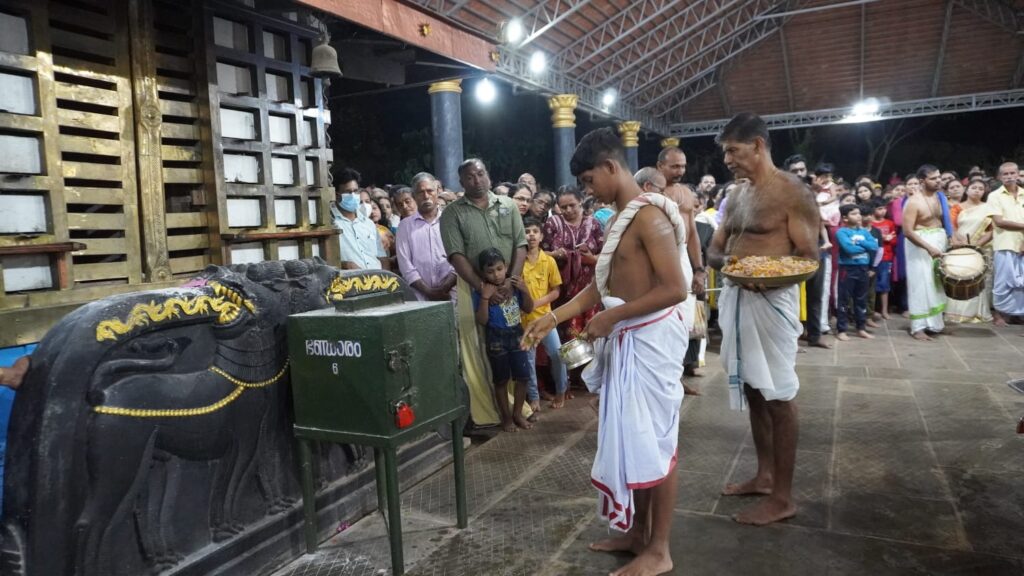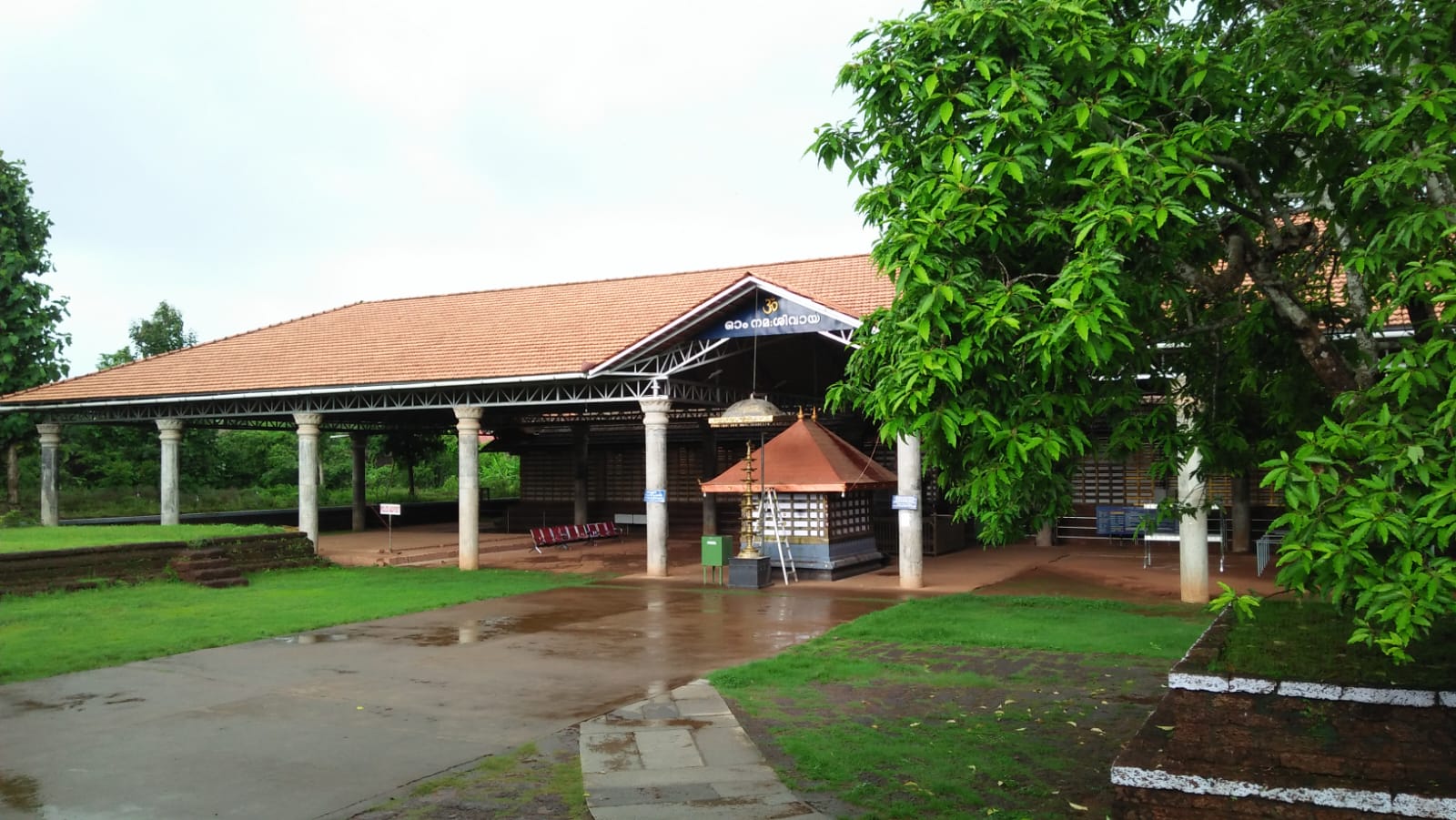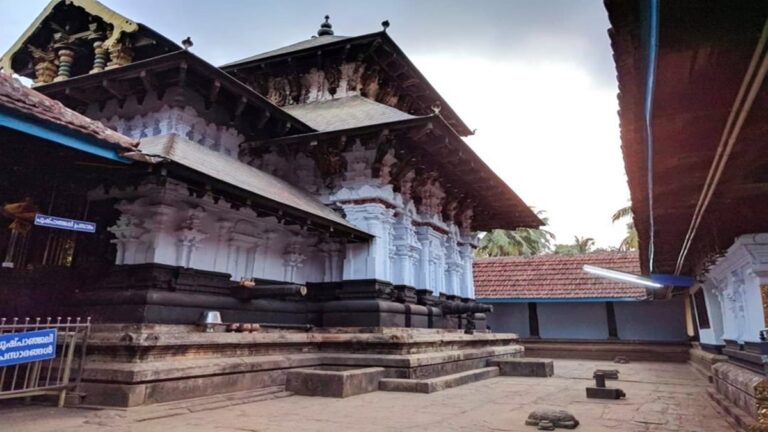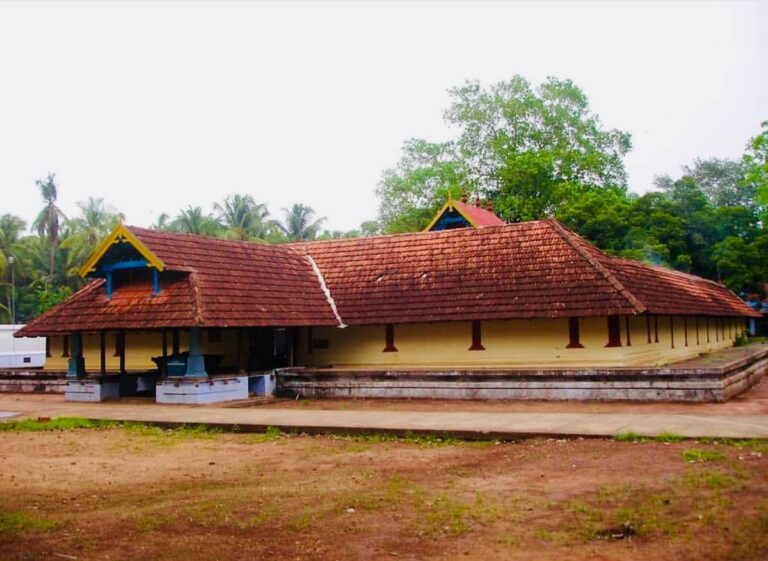Upon my initial entry into the hallowed premises of the Raja Rajeshwara Temple, I was instantly surrounded by a profound sense of spirituality and timeless magnificence. It was a moment in which the passage of time appeared to halt.
About Raja Rajeshwara Temple
Nestled in Taliparamba, Kerala, this temple is special—it’s one of the oldest Shiva temples in the region and has the tallest tower of its time, weighing a whopping 90 tons!
The Raja Rajeshwara temple holds a special place among the 108 ancient Shiva temples in Kerala, just like the famous Shiva temples in Vaikom, Ettumanur, and Vadakkumnathan temple in Trichur.
But beyond its impressive history, what makes it truly remarkable is its beauty. Everywhere you look, there are stories etched in stones, telling tales of devotion and craftsmanship. It’s like stepping into a time machine, where every corner has a story to tell.
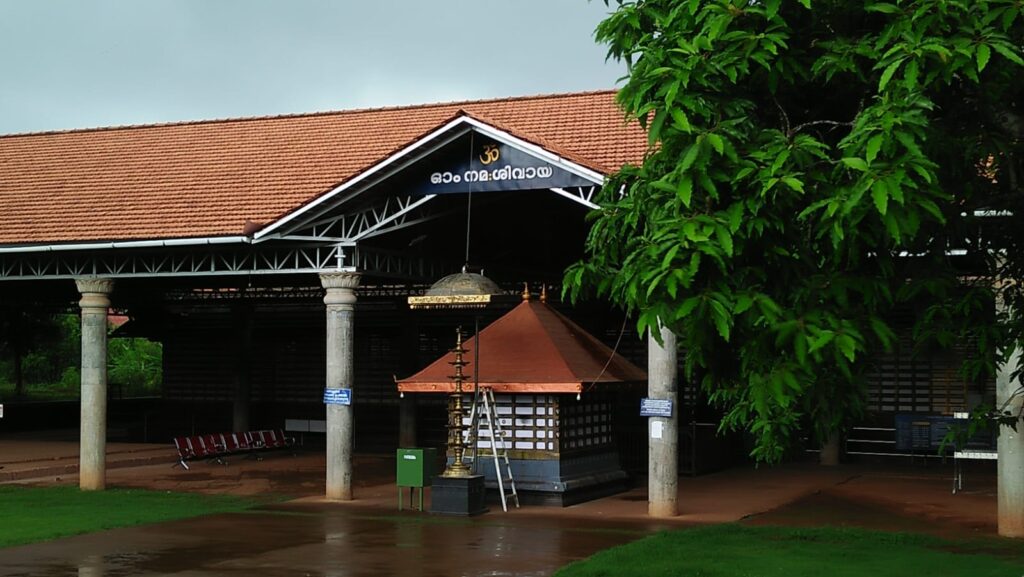
Quick Information
| Nearest Airport Mangaluru (IXE) | Approximately 130 Kms |
| Travel Time from Mangaluru | Approximately 4 hrs 30 mins |
| Travel Option from Mangaluru | Private Taxi, Train, Busses |
| Optional Airport Kozhikode (CCJ) | Approximately 140 Kms |
| Travel Time from Kozhikode | Approximately 4 hrs 30 mins |
| Travel Option | Private Taxi, Train, Busses |
| Nearest Railway Staion | Payyannur (Station Code – PAY), Approximately 23 Kms |
| Travel Options | Taxi, Busses |
| Nearest Bus Station | Thaliparamba Bus Station is well connected with all the nearby cities |
| Dress Code | Men are expected to wear traditional attire such as dhoti and women sarees or salwar suits |
| Temple Timings | 5:00 AM – 12:00 PM and 5:00 PM – 8:30 PM |
The History & Legends
History
The Raja Rajeshwara Temple’s origins are steeped in legend. Built by Parasurama, the sixth avatar of Lord Vishnu, as a form of penance, it’s one of the 108 Shiva temples in the land. Over time, it’s endured the ebb and flow of history.
Legend also tells of Shiva granting 13 sacred Shivalingas to Parvati, one of which found its way to Taliparamba through the sage Maandhata’s prayers. Through generations, the Lingas disappeared and reappeared until one came into the possession of King Satasoman, who built the temple under sage Agastya’s guidance. Some tales even say Agastya himself installed the Linga, possibly a “Jyothirlingam.”
Legends
Legend has it that the Raja Rajeshwara Temple wasn’t just built by any mortal hand; it was the penance of Parasurama, the sixth avatar of Lord Vishnu. He sought redemption for the weight of his actions, and so he raised this sacred place as one of the 108 Shiva temples across the land.
Over the centuries, it has witnessed the rise and fall of empires, yet it stands firm as a light of divinity amidst the sands of time.
But the tale doesn’t end there. It’s said that Shri Parvati received 13 sacred Shivalingas from Shiva. Later, with intense prayers and unwavering faith, Maandhata, one of the sages, called upon the divine.
Filled with joy, Shiva bestowed upon Maandhata one of the sacred Shivalingas, accompanied by a divine command—it could only be placed somewhere without a crematorium. After looking around, the sage built the Shiva Linga in Taliparamba Raja Rajeshwara Temple, the most sacred location.
Legend has it that the Linga vanished into the earth after he passed away. Subsequently, Muchukunda, his son, submitted the same prayers to Shiva and obtained a second Shiva Linga, which eventually vanished as well.
Many centuries went by. The region was controlled by Satasoman, a king of the Mushaka/Kolathiri/Chirakkal Royal Family, who received the third Shiva Linga. He was also an ardent devotee. He prayed to Lord Siva, who gave him the Shiva Linga.
Under sage Agastya’s instruction, the current temple was constructed by the king, who erected it there. However, according to numerous stories, Agastya Himself installed the Shiva Linga, which some tales claim is a “Jyothirlingam.”
The Traditional Way of Visiting the Raja Rajeshwara Temple
As per traditions, devotees follow a set path at the Raja Rajeshwara Temple, paying respects to Lord Krishna, and other deities, and finally worshiping Lord Rajarajeswara’s Jyothirlingam. Female devotees wait outside during the day but join in the evening.
Deities
First, as tradition dictates, devotees pay homage to Lord Krishna at the Vasudevapuram shrine, situated on the southern bank of the temple tank. Here, amidst the serene melodies of Krishna’s flute, one finds solace in the unity of all existence. It’s a reminder that Lord Shiva and Lord Vishnu are but different facets of the same divine essence.
Next, as you make your way to the majestic Raja Rajeshwara Temple, pause at the shrine of Sree Bhoothanatha (Kumbhodhara), Lord Shiva’s trusted lieutenant. Known also as Aravathappan, this revered deity accompanies Lord Rajarajeswara on his divine journey.
Entering the temple complex, you’ll be greeted by an expansive courtyard bordered by towering gopurams. The ancient compound wall, a marvel of architecture, stands as a testament to human creativity and devotion.
Before entering the Raja Rajeshwara Temple, take a moment to offer prayers to Vaidyanatha (Kanhirangaatt-Appan), the deity of physicians, located a short distance away. Then, as you walk around the central shrine, pay respects to the Yakshi, a benevolent guardian deity depicted in a charming wooden sculpture.
Continuing your journey, you’ll encounter Rishabha, the mount of Lord Shiva, and the imposing Balikkallu adorned with intricate carvings. As you walk around the Naalambalam, the outer structure surrounding the sanctum sanctorum, don’t forget to worship Goddess Annapoorneshwari and Goddess Bhadrakali, each revered in their own right.
The Jyotirlingam
Finally, enter the inner sanctum to worship Lord Rajarajeswara’s Jyothirlingam, the epitome of divine grace and power. Remember, as is tradition, to circumambulate the sanctum up to the theertha channel, paying homage to the divine at every step.
And for our female devotees, know that while men are allowed within the Naalambalam during the day, women traditionally wait outside. However, after the Athazha pooja in the evening, all are welcome to enter and bask in the divine presence of Lord Rajarajeswara and his divine family.
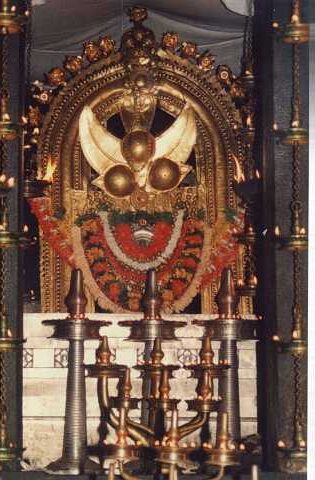
Architecture Overview
Sanctum Sanctorum: The sanctum sanctorum of the Raja Rajeshwara Temple showcases exquisite Kerala temple architecture. It’s a rectangular, two-tiered structure with a roof covered in copper sheets, tapering to a beautiful gold Kalasham.
Entrances: There are four doorways, but only the east and south doors are open. The majestic Jyothirlingam, representing Lord Rajarajeshwara, is visible through the eastern doors.
Lamp Arrangement: Ghee lamps adorn the sanctum, with a special lamp called Bhadradeepam lit by sage Agastya. Rows of silver nilavilakku line the floor, enhancing the sacred ambiance.
Jyothirlingam: The Jyothirlingam features symbols of Lord Shiva like the crescent moon and the Nagaphanam. A golden Prabha and a mythical creature’s face, Vyaalimukham, add to its allure.
Balibimbam and Navarathna Pendant: A representation of the Jyothirlingam called Balibimbam is decorated with priceless stones, pure gold accents, and an embossed golden sheet.
Southern Door: The southern door features a mural painting of Sri Dakshinamoorthi, a form of Lord Shiva, and a shrine to Lord Ganesha on the southwest side.
Additional Shrines: Lord Subrahmanya, another son of Lord Shiva, has a shrine on the northwest corner of Raja Rajeshwara Temple.
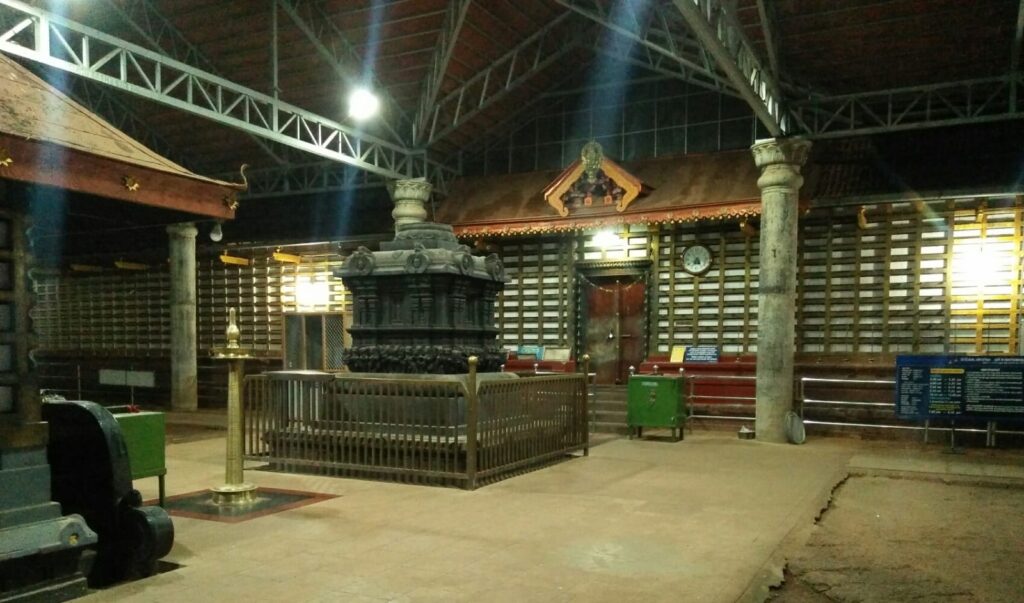
Offerings
Devotee Offerings: Neyy-amrita, Neyy-vilakku, and pattrom are common offerings made by devotees.
Ponnumkudam and Vellikkudam: Ghee-filled Ponnumkudam and Vellikkudam offerings begin with the Natravat pooja.
Significant Offerings: Special prostrations known as Yaamanamaskaaram and Ashwamedha Namaskar, accompanied by Rigvedic mantras, are considered highly significant.
Namaskara Mandapam: Sri Rama’s prayers and offerings at this mandapam during his return to Ayodhya from Lanka are honored. No prostrations are performed here to commemorate this event.
Prasaadam: Devotees receive Thulasi and Vibudhi as prasaadam at Raja Rajeshwara Temple. Thaali, the wedding jewelry, is offered to goddess Parvathi, and powdered turmeric is her prasaadam.
Options for Stay and Vegetarian Restaurants
For those looking to immerse themselves fully in the spiritual ambiance of Taliparamba, there are several accommodation options available nearby, ranging from budget-friendly guesthouses to luxurious resorts.
KTDC Folk Land Parassinikadavu is one of the accommodation options to consider.
Additionally, the town offers a plethora of vegetarian restaurants, serving authentic Kerala cuisine that tantalizes the taste buds and satiates the soul.
Nearby Places to Visit
Taliparamba, apart from the Raja Rajeswara Temple, boasts several other temples and cultural landmarks worth exploring.
- Trichambaram Temple
- Kottiyoor Temple
- Bekel Fort
- Arakkal Museum
- Angelo Fort
- Payyambalam Beach (Drive-in Beach)
- Parassinikadavu Snake Park
Some images from the festival at Raja Rajeshwara Temple

